Abstract
1. The influence of three mechanical factors, force, muscle length and passive lengthening, on long-lasting changes in voluntary force generation, the force:frequency relationship and the development of tenderness has been studied in healthy human skeletal muscle. The elbow flexors were used in all studies. The effect of muscle length was also investigated in the quadriceps and adductor pollicis muscles. Eighty maximal voluntary contractions (MVCs) were performed: one contraction, lasting approximately 2 s, every 15 s. The MVC and force:frequency relationships were measured before and immediately after the exercise and, together with an assessment of tenderness, at 24 h intervals thereafter. 2. In a series of experiments designed to investigate the effects of force, eccentric (lengthening) contractions were found to cause greater fatique and delayed-onset muscle pain than either isometric or concentric (shortening) contractions. There were, however, no substantial differences between the effects of isometric and concentric contractions. Changes in MVC took 24-48 h to return to normal while the low-frequency fatigue required 3-4 days to recover. 3. Passive lengthening with a comparable number of movements over the full range had no effect on the force generation of the muscle, nor did it cause any muscle pain. 4. In the series of experiments designed to investigate the effects of length, isometric MVCs were performed at either short or long length and the muscles subsequently tested at an intermediate length. The contractions at long length resulted in greater low-frequency fatigue and pain, despite the fact that they generated less force than those at the short length. 5. The results demonstrate that there is no simple relationship between the force generated during exercise and the development of long-lasting muscle fatigue and pain. Furthermore, there is a length-dependent component in the generation of low-frequency fatigue and muscle pain.
Full text
PDF



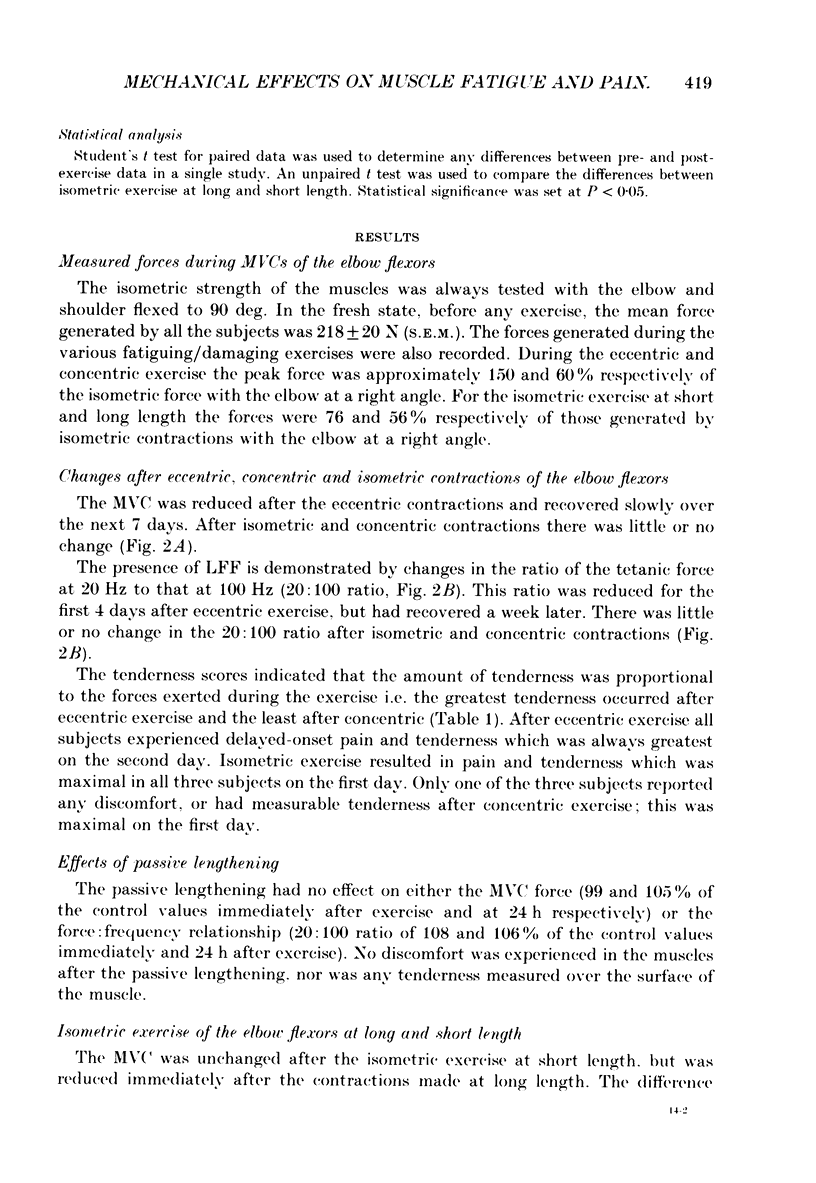

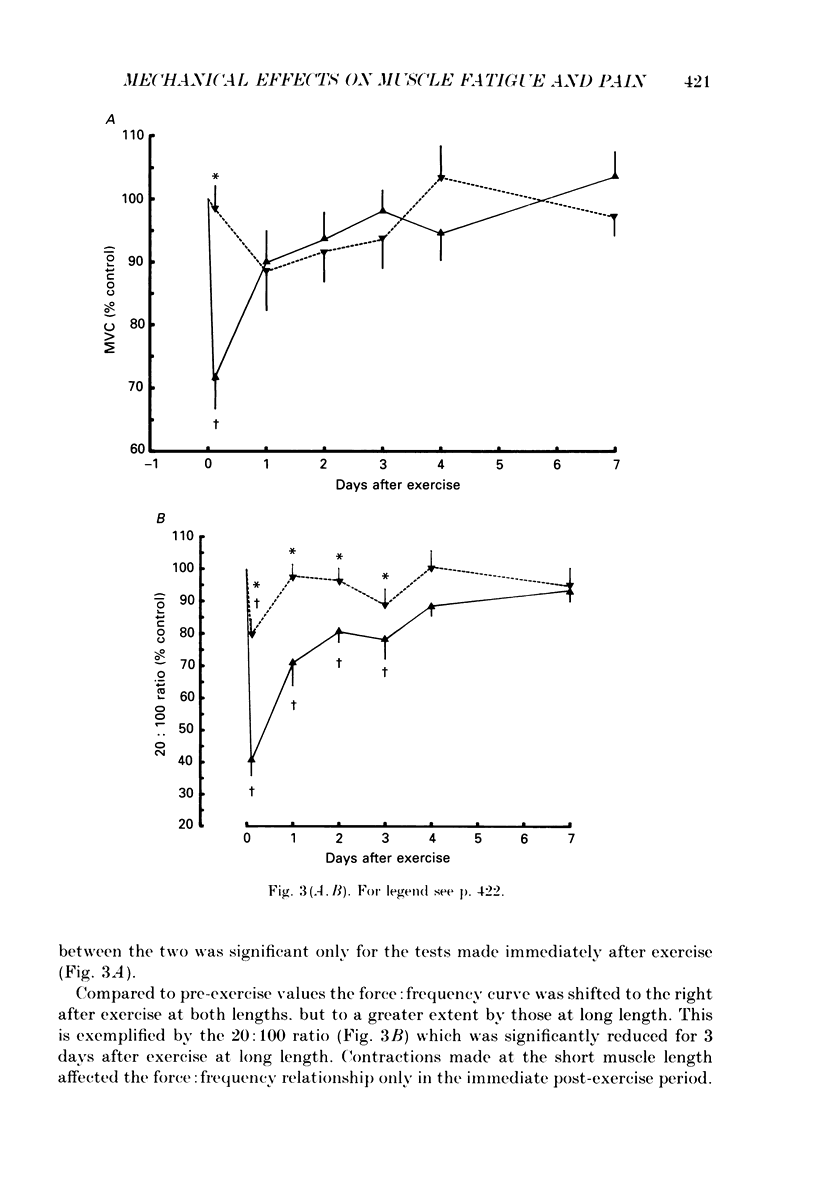
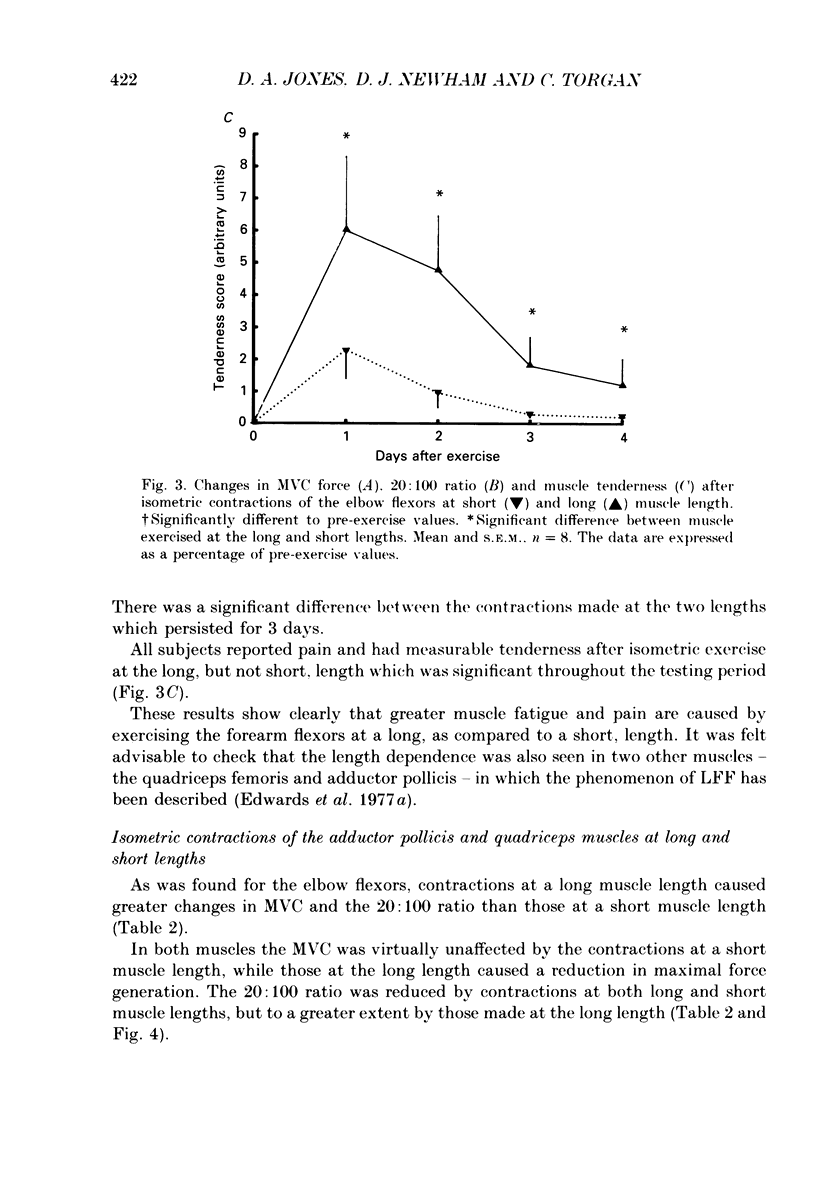


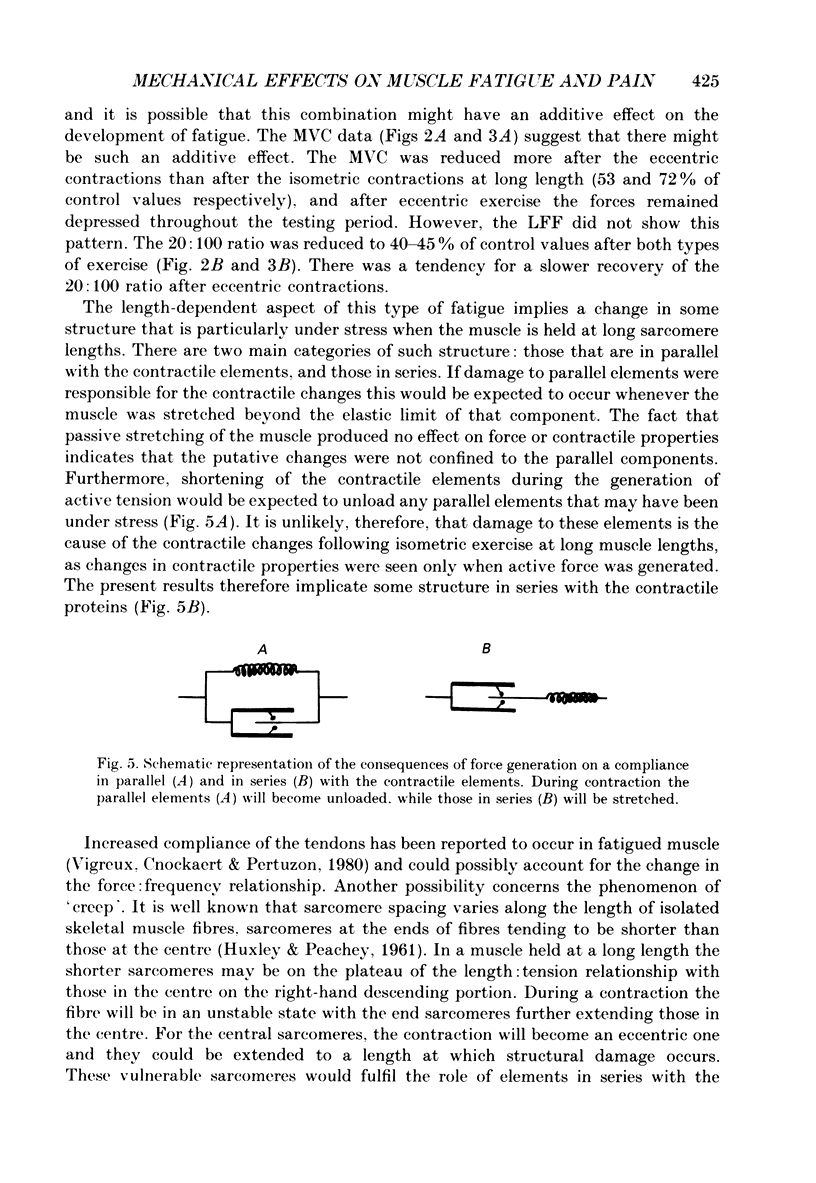
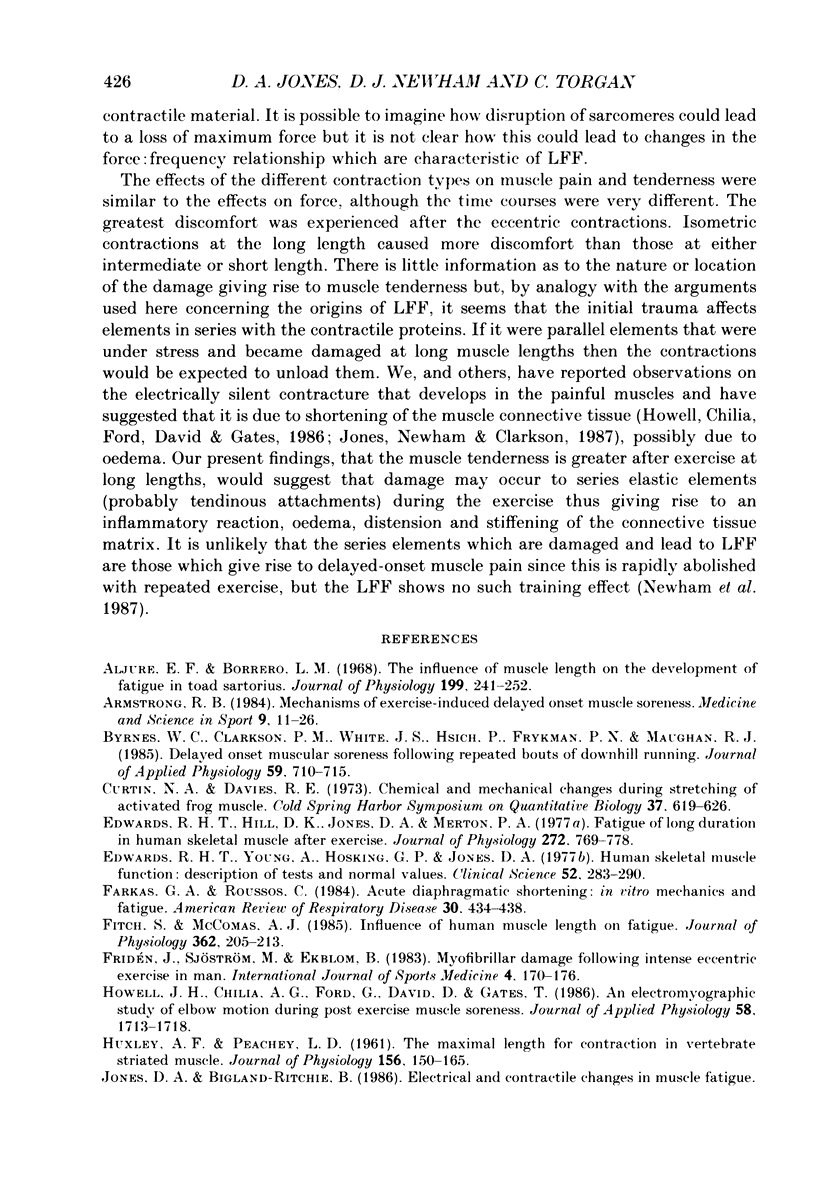
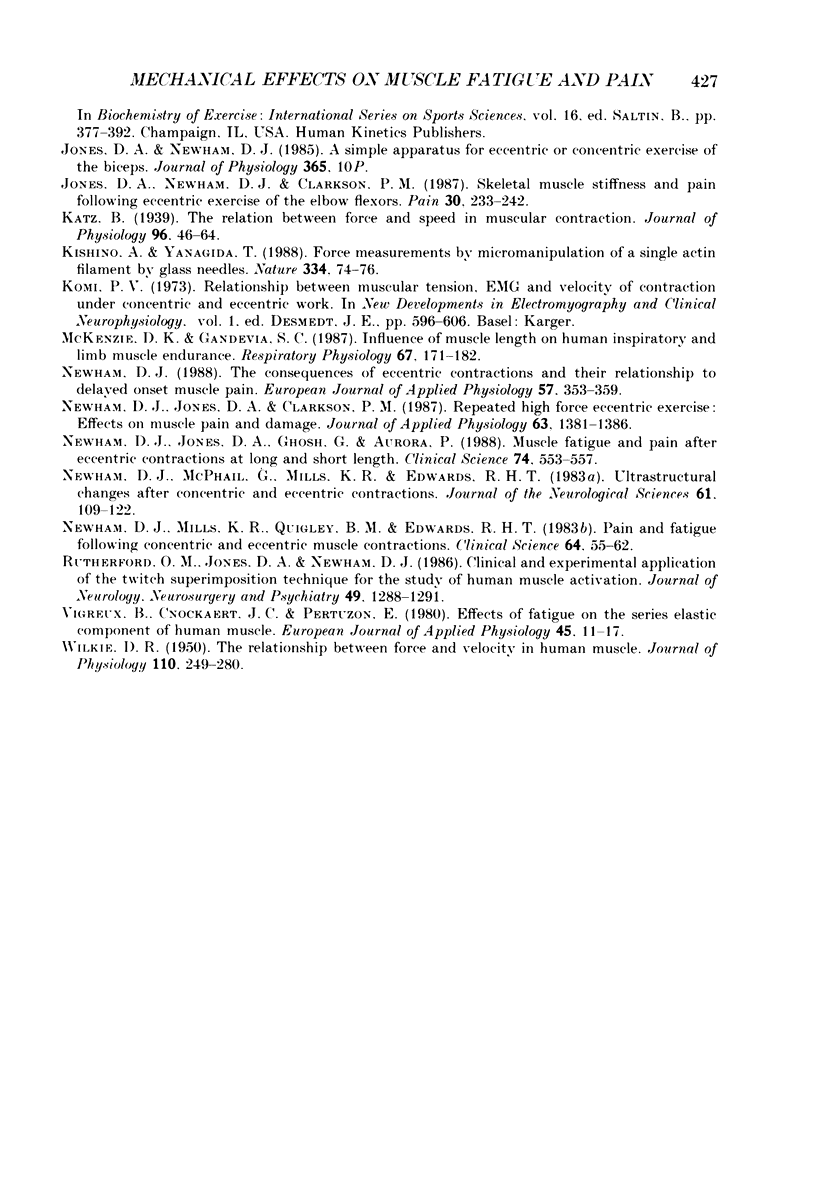
Selected References
These references are in PubMed. This may not be the complete list of references from this article.
- Aljure E. F., Borrero L. M. The influence of muscle length on the development of fatigue in toad sartorus. J Physiol. 1968 Dec;199(2):241–252. doi: 10.1113/jphysiol.1968.sp008651. [DOI] [PMC free article] [PubMed] [Google Scholar]
- Byrnes W. C., Clarkson P. M., White J. S., Hsieh S. S., Frykman P. N., Maughan R. J. Delayed onset muscle soreness following repeated bouts of downhill running. J Appl Physiol (1985) 1985 Sep;59(3):710–715. doi: 10.1152/jappl.1985.59.3.710. [DOI] [PubMed] [Google Scholar]
- Edwards R. H., Hill D. K., Jones D. A., Merton P. A. Fatigue of long duration in human skeletal muscle after exercise. J Physiol. 1977 Nov;272(3):769–778. doi: 10.1113/jphysiol.1977.sp012072. [DOI] [PMC free article] [PubMed] [Google Scholar]
- Edwards R. H., Young A., Hosking G. P., Jones D. A. Human skeletal muscle function: description of tests and normal values. Clin Sci Mol Med. 1977 Mar;52(3):283–290. doi: 10.1042/cs0520283. [DOI] [PubMed] [Google Scholar]
- Farkas G. A., Roussos C. Acute diaphragmatic shortening: in vitro mechanics and fatigue. Am Rev Respir Dis. 1984 Sep;130(3):434–438. doi: 10.1164/arrd.1984.130.3.434. [DOI] [PubMed] [Google Scholar]
- Fitch S., McComas A. Influence of human muscle length on fatigue. J Physiol. 1985 May;362:205–213. doi: 10.1113/jphysiol.1985.sp015671. [DOI] [PMC free article] [PubMed] [Google Scholar]
- Fridén J., Sjöström M., Ekblom B. Myofibrillar damage following intense eccentric exercise in man. Int J Sports Med. 1983 Aug;4(3):170–176. doi: 10.1055/s-2008-1026030. [DOI] [PubMed] [Google Scholar]
- HUXLEY A. F., PEACHEY L. D. The maximum length for contraction in vertebrate straiated muscle. J Physiol. 1961 Apr;156:150–165. doi: 10.1113/jphysiol.1961.sp006665. [DOI] [PMC free article] [PubMed] [Google Scholar]
- Howell J. N., Chila A. G., Ford G., David D., Gates T. An electromyographic study of elbow motion during postexercise muscle soreness. J Appl Physiol (1985) 1985 May;58(5):1713–1718. doi: 10.1152/jappl.1985.58.5.1713. [DOI] [PubMed] [Google Scholar]
- Jones D. A., Newham D. J., Clarkson P. M. Skeletal muscle stiffness and pain following eccentric exercise of the elbow flexors. Pain. 1987 Aug;30(2):233–242. doi: 10.1016/0304-3959(87)91079-7. [DOI] [PubMed] [Google Scholar]
- Katz B. The relation between force and speed in muscular contraction. J Physiol. 1939 Jun 14;96(1):45–64. doi: 10.1113/jphysiol.1939.sp003756. [DOI] [PMC free article] [PubMed] [Google Scholar]
- Kishino A., Yanagida T. Force measurements by micromanipulation of a single actin filament by glass needles. Nature. 1988 Jul 7;334(6177):74–76. doi: 10.1038/334074a0. [DOI] [PubMed] [Google Scholar]
- McKenzie D. K., Gandevia S. C. Influence of muscle length on human inspiratory and limb muscle endurance. Respir Physiol. 1987 Feb;67(2):171–182. doi: 10.1016/0034-5687(87)90039-9. [DOI] [PubMed] [Google Scholar]
- Newham D. J., Jones D. A., Clarkson P. M. Repeated high-force eccentric exercise: effects on muscle pain and damage. J Appl Physiol (1985) 1987 Oct;63(4):1381–1386. doi: 10.1152/jappl.1987.63.4.1381. [DOI] [PubMed] [Google Scholar]
- Newham D. J., Jones D. A., Ghosh G., Aurora P. Muscle fatigue and pain after eccentric contractions at long and short length. Clin Sci (Lond) 1988 May;74(5):553–557. doi: 10.1042/cs0740553. [DOI] [PubMed] [Google Scholar]
- Newham D. J., McPhail G., Mills K. R., Edwards R. H. Ultrastructural changes after concentric and eccentric contractions of human muscle. J Neurol Sci. 1983 Sep;61(1):109–122. doi: 10.1016/0022-510x(83)90058-8. [DOI] [PubMed] [Google Scholar]
- Newham D. J., Mills K. R., Quigley B. M., Edwards R. H. Pain and fatigue after concentric and eccentric muscle contractions. Clin Sci (Lond) 1983 Jan;64(1):55–62. doi: 10.1042/cs0640055. [DOI] [PubMed] [Google Scholar]
- Newham D. J. The consequences of eccentric contractions and their relationship to delayed onset muscle pain. Eur J Appl Physiol Occup Physiol. 1988;57(3):353–359. doi: 10.1007/BF00635995. [DOI] [PubMed] [Google Scholar]
- Rutherford O. M., Jones D. A., Newham D. J. Clinical and experimental application of the percutaneous twitch superimposition technique for the study of human muscle activation. J Neurol Neurosurg Psychiatry. 1986 Nov;49(11):1288–1291. doi: 10.1136/jnnp.49.11.1288. [DOI] [PMC free article] [PubMed] [Google Scholar]
- Vigreux B., Cnockaert J. C., Pertuzon E. Effects of fatigue on the series elastic component of human muscle. Eur J Appl Physiol Occup Physiol. 1980;45(1):11–17. doi: 10.1007/BF00421196. [DOI] [PubMed] [Google Scholar]


